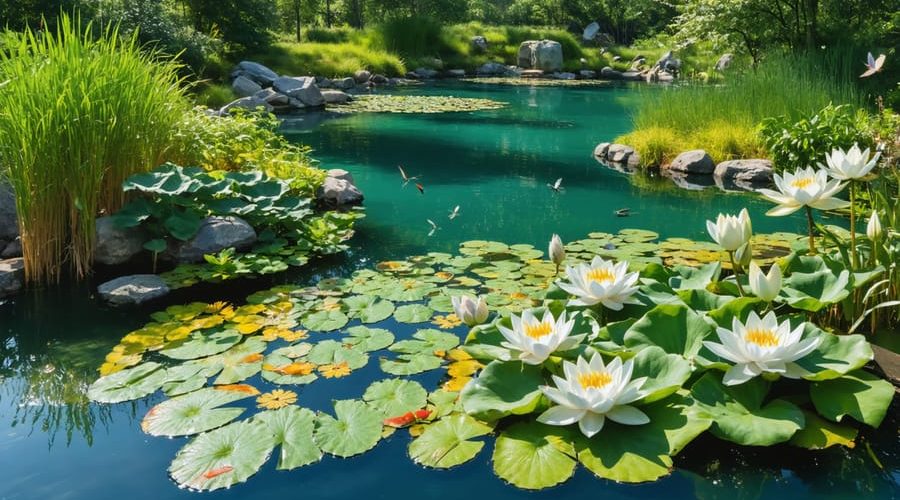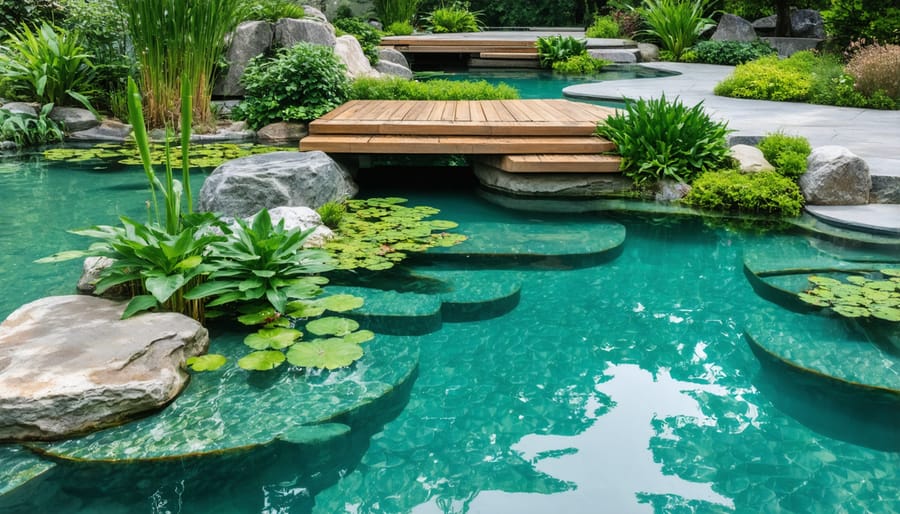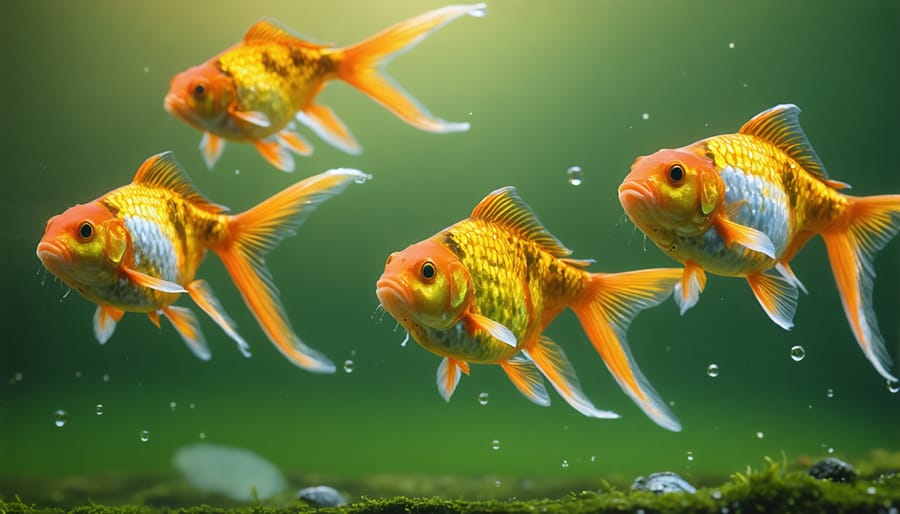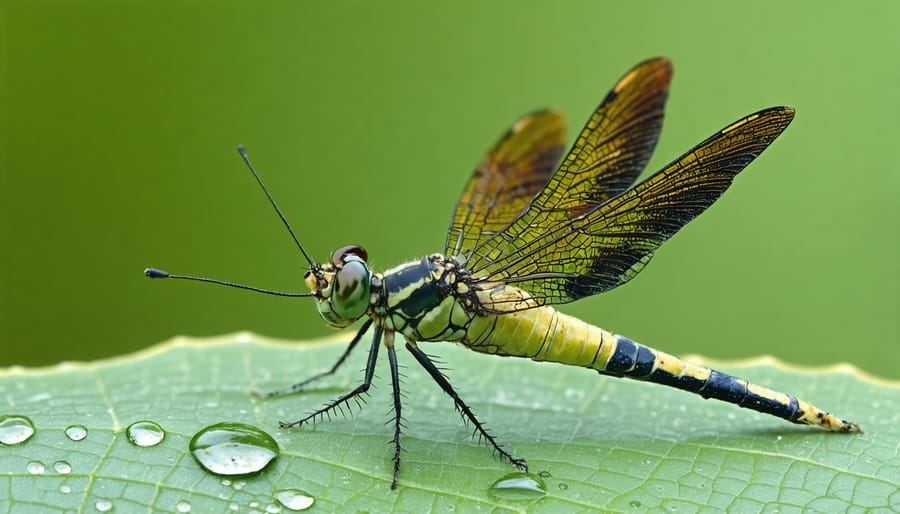
Create a Thriving Water Garden That Preserves Local Wildlife
Creating thriving ecosystems in water gardens demands a delicate balance of natural elements and human stewardship. To transform your water garden into a sustainable sanctuary for biodiversity, start by selecting native aquatic plants that provide natural filtration and habitat zones at varying depths. Incorporate at least three different water levels—shallow margins, mid-depth shelves, and deep zones—to support diverse species from amphibians to dragonflies. Layer your pond ecosystem with submerged oxygenators, floating plants, and marginal vegetation to create a self-sustaining environment that naturally controls algae and maintains water quality.
This approach to biodiversity isn’t just about aesthetics—it’s about building resilient ecosystems that thrive with minimal intervention. By mimicking natural pond systems, we create environments where beneficial insects, native fish, and local wildlife can establish permanent populations, contributing to the broader ecological network in our communities. Each carefully selected plant and thoughtfully designed zone works together, forming a living tapestry that supports itself while enriching our outdoor spaces with vibrant life and natural beauty.
Building a Balanced Ecosystem in Your Water Garden
Native Plants: Your Garden’s Foundation
Creating a sustainable water garden starts with choosing the right native aquatic plants. These indigenous species are your ecosystem’s backbone, naturally adapted to local conditions and perfectly suited to support local wildlife. When selecting plants, consider creating perfect plant combinations that include different growing heights and water depths.
Start with marginal plants like native rushes and sedges along the pond’s edges. These plants not only look beautiful but also provide essential shelter for frogs and beneficial insects. In slightly deeper water, consider adding local water lilies or lotus varieties that offer surface coverage and create natural hiding spots for fish.
Don’t forget about submerged plants – they’re the underwater workhorses that help maintain water quality and provide oxygen. Look for native species like pondweed or hornwort that naturally occur in your local waterways.
Before adding any plants, check with your local native plant nursery or water garden specialist to ensure your choices aren’t potentially invasive. They can recommend species that thrive in your specific climate while supporting local biodiversity. Remember, native plants typically require less maintenance and naturally resist local pests, making them an excellent choice for sustainable water gardening.
For best results, group plants with similar water depth and sunlight requirements together, creating natural-looking zones that mirror what you’d find in local wetlands.
Creating Wildlife-Friendly Zones
Creating wildlife-friendly zones in your water garden starts with understanding how to establish different depth zones that mimic natural habitats. Start by designing a shallow marsh area (0-6 inches deep) where beneficial insects and amphibians can thrive. This zone is perfect for marginal plants like rushes and water iris, which provide cover for small creatures.
Next, create a medium-depth shelf (6-12 inches) where aquatic plants like water lilies can flourish. This area serves as a feeding ground for birds and supports a variety of pond life. The deep zone (2-4 feet) offers sanctuary for fish during extreme weather and helps maintain stable water temperatures.
Don’t forget to include gently sloping sides rather than steep drops – this allows wildlife to enter and exit safely. Add partially submerged logs or rocks to create basking spots for turtles and resting places for birds. Native plants should make up at least 60% of your vegetation to attract local wildlife and maintain ecological balance.
Create small hideaways using rock clusters and aquatic plants to protect smaller creatures from predators. Leave some open water areas for insects like dragonflies that need space to patrol and hunt. Remember to avoid using chemicals and opt for natural filtering systems to keep the water clean and healthy for all inhabitants.

Smart Fish Selection for Long-Term Success
Compatible Fish Communities
Creating harmonious fish communities is essential for maintaining a balanced aquatic ecosystem. Start by selecting fish species that occupy different water levels – surface feeders like guppies, mid-water swimmers such as tetras, and bottom dwellers like corydoras catfish. This vertical distribution ensures efficient use of space and resources.
Consider the adult size and temperament of each species. Peaceful community fish like mollies, platies, and rasboras make excellent companions, while aggressive species like cichlids may disrupt the harmony. Always research the specific requirements of each species, including water temperature, pH preferences, and social behaviors.
A good rule of thumb is to introduce fish gradually, starting with hardier species and adding more delicate ones once the ecosystem stabilizes. Keep in mind the carrying capacity of your water body – overcrowding can lead to stress, disease, and poor water quality.
Group similar species together, as schooling fish feel more secure in numbers. This natural behavior reduces stress and creates stunning visual displays. For outdoor ponds, consider native species that are adapted to local conditions and can contribute to regional biodiversity.
Remember to maintain proper filtration and regular water quality checks to support your fish community’s health and longevity.

Population Management
Managing fish populations is key to maintaining a healthy, balanced ecosystem in your water garden. Start by calculating your pond’s capacity – a general rule of thumb is one inch of fish per 10 gallons of water. This helps prevent overcrowding, which can lead to oxygen depletion and increased waste.
Monitor your fish regularly for signs of breeding. While baby fish are exciting, unchecked reproduction can quickly overwhelm your pond. Consider introducing natural predators like dragonfly nymphs or separating males and females during breeding season if population control becomes necessary.
Create different depth zones in your pond to provide various habitats and hiding spots. This natural approach helps maintain population balance by allowing smaller fish to escape predators while giving larger fish their own territory.
Feed your fish appropriately – overfeeding leads to excess waste and can encourage overpopulation. During warmer months, feed small portions 2-3 times daily, reducing to once daily or not at all during winter months.
If your pond becomes overcrowded, consider rehoming excess fish to local garden centers or fellow pond enthusiasts. Some aquatic plants can also help manage fish populations by providing natural spacing and territory markers while contributing to better water quality.
Remember, a balanced fish population creates a more sustainable and enjoyable water garden for everyone.
Natural Maintenance Methods
Chemical-Free Water Quality Control
Natural methods offer an eco-friendly approach to maintain water clarity without harsh chemicals. By incorporating aquatic plants like water lilies and submerged oxygenators, you create a natural filtration system that keeps your pond balanced. These plants absorb excess nutrients and provide shelter for beneficial microorganisms that help break down organic matter.
Adding barley straw is another time-tested solution that naturally inhibits algae growth. Simply place a small bundle in a mesh bag and float it in your pond. As it decomposes, it releases compounds that discourage algae while remaining completely safe for fish and other wildlife.
Creating a diverse ecosystem is key to natural water quality control. Include different types of plants at various depths, from marginal to floating varieties. This plant diversity helps regulate nutrient levels and provides multiple layers of filtration. Consider adding beneficial bacteria starter cultures to jump-start the biological filtering process.
Movement is essential for healthy water. A small solar-powered fountain or waterfall not only adds visual appeal but also increases oxygen levels and promotes better circulation. This natural aeration helps prevent stagnant areas where problems typically develop.
Remember to maintain a healthy balance of fish to water volume, as overcrowding can lead to water quality issues. Regular monitoring and gentle maintenance, like removing fallen leaves and trimming dead plant material, will keep your water garden thriving naturally.

Beneficial Insects and Microorganisms
Creating a thriving ecosystem in your water garden means welcoming beneficial insects and microorganisms that help maintain natural balance. Dragonflies and damselflies are excellent additions as they control mosquito populations while adding vibrant colors to your garden. To attract these helpful insects, incorporate various water depths and plenty of native plants around your pond’s edges.
Water beetles and aquatic bugs serve as natural cleaners, feeding on decomposing matter and helping to maintain water quality. Meanwhile, beneficial bacteria and other microorganisms break down organic waste and help prevent algae overgrowth. To encourage these tiny helpers, avoid using harsh chemicals and maintain proper filtration.
Creating shallow areas with stones and plants provides perfect habitats for predatory insects that keep pest populations in check. Consider adding floating plants like water lilies, which offer shelter for beneficial insects while providing natural shade that helps regulate water temperature.
To maintain a healthy balance of beneficial creatures:
– Leave fallen leaves and organic matter in designated areas
– Install different types of aquatic plants
– Create varying water depths
– Minimize artificial lighting around the pond
– Avoid using pesticides near your water garden
– Add rock piles or wooden structures as insect shelters
Remember that establishing a balanced ecosystem takes time, but once achieved, these beneficial creatures will help your water garden flourish naturally with minimal intervention.
Seasonal Care for Biodiversity
Spring and Summer Management
As temperatures rise, spring and summer present unique opportunities to enhance biodiversity in your garden ecosystem. Start by gradually introducing native aquatic plants as the water warms, focusing on a mix of floating, submerged, and marginal species. These plants not only provide shelter for wildlife but also help maintain water quality naturally.
Encourage beneficial insects by creating shallow areas where they can safely access water. Adding small rocks or branches that emerge slightly above the water surface creates perfect perches for dragonflies, which help control mosquito populations. Consider installing a simple solar-powered fountain to keep water moving, preventing algae buildup and attracting more diverse wildlife.
Monitor water levels regularly during hot spells, topping up when necessary with rainwater if possible. This helps maintain stable conditions for aquatic life. Trim back excessive plant growth to prevent overcrowding, but avoid removing more than a third of floating plants at once to maintain water quality and shelter for pond inhabitants.
Summer is also ideal for adding new wildlife-friendly features. Consider creating a butterfl puddling station near your water feature using shallow dishes filled with damp sand and mineral-rich soil. Leave some areas of longer grass around your water feature – these natural corridors help amphibians move safely between aquatic and terrestrial habitats.
Remember to resist the urge to over-clean during this active season. Some organic matter and gentle algae growth are natural and beneficial for supporting a diverse ecosystem.
Fall and Winter Protection
As temperatures drop, protecting your garden’s biodiversity becomes crucial for maintaining a healthy ecosystem through the colder months. Start by gradually reducing feeding as winter approaches, allowing natural systems to prepare for dormancy. Cover your pond with a net before autumn leaves begin to fall – this prevents excessive organic matter from decomposing in the water and maintains water quality for overwintering creatures.
For deeper ponds, consider installing a floating de-icer to maintain a small opening in the ice. This allows vital gas exchange and provides access for wildlife that depends on the water source. However, avoid breaking ice directly on the pond surface, as this can harm hibernating animals.
Create winter shelters around your pond using fallen branches, logs, and leaf piles. These natural structures provide essential refuge for amphibians, beneficial insects, and small mammals. Leave some plant stalks standing through winter – they offer valuable protection for beneficial insects and create natural snow barriers.
Consider adding cold-hardy native plants that provide food and shelter during harsh weather. Berry-producing shrubs and evergreens not only maintain visual interest but also support local bird populations. In areas with heavy snowfall, install windbreaks using natural materials to protect delicate ecosystem elements.
Remember to maintain any existing wildlife corridors connecting your garden to neighboring natural areas. These pathways become especially important during winter when food sources are scarce and animals need to move between different habitats for survival.
As we’ve explored throughout this article, maintaining biodiversity in our water gardens isn’t just about creating beautiful spaces – it’s about being responsible stewards of our local ecosystems. By choosing native plants, providing diverse habitats, and using natural maintenance methods, we can create thriving environments that support local wildlife while enjoying stunning water features in our gardens.
Remember that every small action counts. Whether you’re creating hiding spots for beneficial insects, installing bird-friendly features, or choosing chemical-free maintenance methods, you’re contributing to a larger network of sustainable gardens that help preserve our planet’s biodiversity.
Start with simple steps: introduce one or two native plant species, create a small wildlife shelter, or switch to natural cleaning methods. As you become more comfortable, gradually expand your sustainable practices. The rewards are worth it – from the chorus of frogs in spring to the dance of dragonflies in summer, your water garden will become a living showcase of nature’s diversity.
Let’s all do our part in protecting and promoting biodiversity. Your water garden can be more than just a beautiful feature in your landscape – it can be a vital sanctuary for local wildlife and a model of sustainable gardening practices for your community. Together, we can create a network of healthy, vibrant ecosystems, one water garden at a time.
